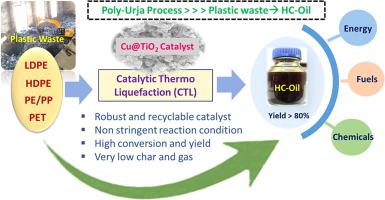Our official English website, www.x-mol.net, welcomes your feedback! (Note: you will need to create a separate account there.)
A Cu doped TiO2 catalyst mediated Catalytic Thermo Liquefaction (CTL) of polyolefinic plastic waste into hydrocarbon oil
Fuel ( IF 7.4 ) Pub Date : 2021-02-01 , DOI: 10.1016/j.fuel.2020.119155 Tejas M. Ukarde , Hitesh S. Pawar
Fuel ( IF 7.4 ) Pub Date : 2021-02-01 , DOI: 10.1016/j.fuel.2020.119155 Tejas M. Ukarde , Hitesh S. Pawar

|
Abstract Plastic waste has been identified as a potent feedstock for liquefaction to produce hydrocarbon liquid oil (HC-Oil) by employing Catalytic Thermo Liquefaction (CTL). The resulting process for liquefaction of plastic was termed as Poly-Urja process and produced hydrocarbon oil was termed as HC-Oil. The CTL explores copper doped TiO2 (Cu@TiO2) catalyst as a selective, robust, non-toxic, inexpensive and promising material for liquefaction of polyolefinic plastic waste with minimum char and gas formation. The use of simple, non-expensive and non-complex co-precipitation method has provided a series of Cu@TiO2 catalysts with variable composition of the metal. Of the synthesized catalysts, Cu@TiO2 with 5% metal loading gave maximum conversion and yield of HC-Oil in laboratory batch reactor. The physicochemical and surface morphological properties of the catalyst were studied by using ATR-FTIR, XRD, SEM-EDX, BET and ICP-MS. Process intensification study was conducted to obtain maximum conversion and yield. The intensified CTL process gave >85% conversion and >80% yield of HC-Oil at less stringent conditions. HC-Oil is a carbon rich substrate comprises of 75–85% carbon, 5–15% hydrogen, 5–10% other elements and have a calorific value of ~42 MJ/kg thus it can be used for multiple applications of energy, fuels and chemicals etc. Physicochemical characterization of HC-Oil showed the presence of long and short; straight and branched chains of hydrocarbons (C8-C28). Moreover, CTL can convert any combination of plastic waste into HC-Oil with minimum carbon loss and >80% yield. Thus, the CTL process for polyolefinic waste provides an efficient, sustainable and environmentally friendly alternative to convert plastic waste into energy.
中文翻译:

Cu掺杂的二氧化钛催化剂介导的聚烯烃塑料废物催化热液化(CTL)成烃油
摘要 塑料废物已被确定为利用催化热液化 (CTL) 液化生产烃类液体油 (HC-Oil) 的有效原料。由此产生的塑料液化过程称为 Poly-Urja 过程,生产的烃油称为 HC-Oil。CTL 探索了铜掺杂的 TiO2 (Cu@TiO2) 催化剂作为一种选择性、坚固、无毒、廉价且有前途的材料,用于液化聚烯烃塑料废物,同时形成最少的炭和气体。使用简单、不昂贵和不复杂的共沉淀方法提供了一系列金属成分可变的Cu@TiO2催化剂。在合成的催化剂中,5% 金属负载量的 Cu@TiO2 在实验室间歇式反应器中提供了最大的转化率和 HC-Oil 的产率。采用ATR-FTIR、XRD、SEM-EDX、BET和ICP-MS对催化剂的理化和表面形貌进行了研究。进行工艺强化研究以获得最大转化率和产率。强化的 CTL 过程在不太严格的条件下产生 >85% 的转化率和 >80% 的 HC-Oil 产率。HC-Oil 是一种富含碳的底物,由 75-85% 的碳、5-15% 的氢、5-10% 的其他元素组成,热值约为 42 MJ/kg,因此可用于多种能源应用,燃料和化学品等。HC-Oil 的物理化学特征显示存在多头和空头;直链和支链烃(C8-C28)。此外,CTL 可以将任何组合的塑料废物转化为 HC-Oil,碳损失最小,收率大于 80%。因此,
更新日期:2021-02-01
中文翻译:

Cu掺杂的二氧化钛催化剂介导的聚烯烃塑料废物催化热液化(CTL)成烃油
摘要 塑料废物已被确定为利用催化热液化 (CTL) 液化生产烃类液体油 (HC-Oil) 的有效原料。由此产生的塑料液化过程称为 Poly-Urja 过程,生产的烃油称为 HC-Oil。CTL 探索了铜掺杂的 TiO2 (Cu@TiO2) 催化剂作为一种选择性、坚固、无毒、廉价且有前途的材料,用于液化聚烯烃塑料废物,同时形成最少的炭和气体。使用简单、不昂贵和不复杂的共沉淀方法提供了一系列金属成分可变的Cu@TiO2催化剂。在合成的催化剂中,5% 金属负载量的 Cu@TiO2 在实验室间歇式反应器中提供了最大的转化率和 HC-Oil 的产率。采用ATR-FTIR、XRD、SEM-EDX、BET和ICP-MS对催化剂的理化和表面形貌进行了研究。进行工艺强化研究以获得最大转化率和产率。强化的 CTL 过程在不太严格的条件下产生 >85% 的转化率和 >80% 的 HC-Oil 产率。HC-Oil 是一种富含碳的底物,由 75-85% 的碳、5-15% 的氢、5-10% 的其他元素组成,热值约为 42 MJ/kg,因此可用于多种能源应用,燃料和化学品等。HC-Oil 的物理化学特征显示存在多头和空头;直链和支链烃(C8-C28)。此外,CTL 可以将任何组合的塑料废物转化为 HC-Oil,碳损失最小,收率大于 80%。因此,



























 京公网安备 11010802027423号
京公网安备 11010802027423号